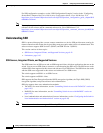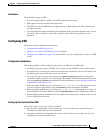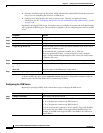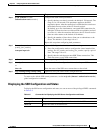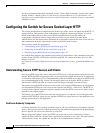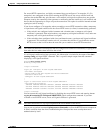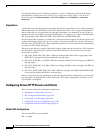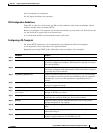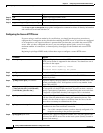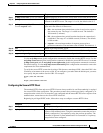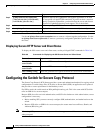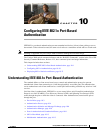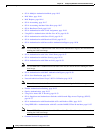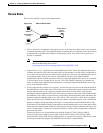
9-50
Catalyst 2960 and 2960-S Switch Software Configuration Guide
OL-8603-09
Chapter 9 Configuring Switch-Based Authentication
Configuring the Switch for Secure Socket Layer HTTP
Use the no crypto ca trustpoint name global configuration command to delete all identity information
and certificates associated with the CA.
Configuring the Secure HTTP Server
If you are using a certificate authority for certification, you should use the previous procedure to
configure the CA trustpoint on the switch before enabling the HTTP server. If you have not configured
a CA trustpoint, a self-signed certificate is generated the first time that you enable the secure HTTP
server. After you have configured the server, you can configure options (path, access list to apply,
maximum number of connections, or timeout policy) that apply to both standard and secure HTTP
servers.
Beginning in privileged EXEC mode, follow these steps to configure a secure HTTP server:
Step 13
end Return to privileged EXEC mode.
Step 14
show crypto ca trustpoints Verify the configuration.
Step 15
copy running-config startup-config (Optional) Save your entries in the configuration file.
Command Purpose
Command Purpose
Step 1
show ip http server status (Optional) Display the status of the HTTP server to determine if the secure
HTTP server feature is supported in the software. You should see one of
these lines in the output:
HTTP secure server capability: Present
or
HTTP secure server capability: Not present
Step 2
configure terminal Enter global configuration mode.
Step 3
ip http secure-server Enable the HTTPS server if it has been disabled. The HTTPS server is
enabled by default.
Step 4
ip http secure-port port-number (Optional) Specify the port number to be used for the HTTPS server. The
default port number is 443. Valid options are 443 or any number in the
range 1025 to 65535.
Step 5
ip http secure-ciphersuite
{[3des-ede-cbc-sha] [rc4-128-md5]
[rc4-128-sha] [des-cbc-sha]}
(Optional) Specify the CipherSuites (encryption algorithms) to be used
for encryption over the HTTPS connection. If you do not have a reason to
specify a particularly CipherSuite, you should allow the server and client
to negotiate a CipherSuite that they both support. This is the default.
Step 6
ip http secure-client-auth (Optional) Configure the HTTP server to request an X.509v3 certificate
from the client for authentication during the connection process. The
default is for the client to request a certificate from the server, but the
server does not attempt to authenticate the client.
Step 7
ip http secure-trustpoint name Specify the CA trustpoint to use to get an X.509v3 security certificate and
to authenticate the client certificate connection.
Note Use of this command assumes you have already configured a CA
trustpoint according to the previous procedure.
Step 8
ip http path path-name (Optional) Set a base HTTP path for HTML files. The path specifies the
location of the HTTP server files on the local system (usually located in
system flash memory).



